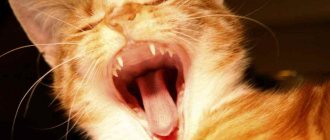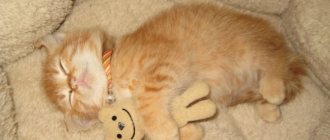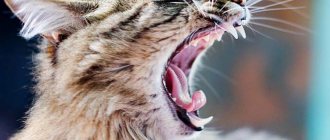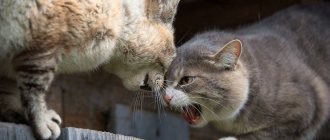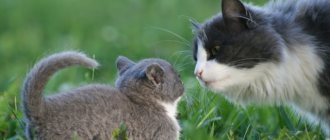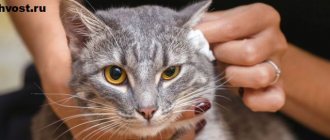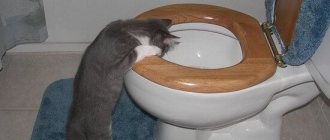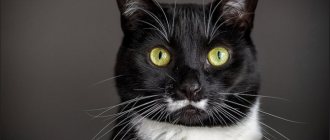When do kittens get their first teeth?
Cats, like other mammals, are born toothless. In this way, nature protects their mothers from bitten nipples and pain. The first teeth appear at about two weeks of age. Then only the incisors come out, but our pets acquire fangs only by 3-4 weeks. So imagine, if you take home and wean a kitten from its mother at 4 weeks, you must understand that it has just started to have teeth. But at 2-3 months, cats already have all two rows (26 milk teeth) - and their owners are able to absorb even pieces of meat.
Kitten teeth at 2 months
What difficulties may arise when changing teeth?
When the permanent tooth grows, the milk tooth falls out. Sometimes baby teeth are very resistant and do not fall out. Most often this applies to canines and incisors. If the baby tooth does not fall out, the permanent tooth comes out nearby. This can lead to certain problems:
- Remnants of food get stuck between two teeth that are located close to each other. This increases the risk of plaque and tartar formation.
- When a permanent tooth emerges next to a baby tooth, it can cause displacement. Misaligned teeth rub against others, the enamel wears off, and the teeth become weak.
- If the primary lower canines have not fallen out, the permanent canines usually grow on the inside of the jaw. The tip of the fang touches the upper jaw. In addition to the fact that it may be painful, it becomes uncomfortable for the kitten to eat.
Two teeth should not grow in the same socket. If your kitten has not lost a baby tooth, but a permanent tooth has grown nearby, you need to take your pet to the veterinarian. If a baby tooth doesn't move (a sign that it's about to fall out), your doctor will likely recommend extraction. The sooner a specialist removes an extra baby tooth, the higher the likelihood that the permanent teeth will grow correctly and the animal’s bite will not be disturbed.
The baby tooth has not yet fallen out, but a permanent tooth is already growing in the same hole. This shouldn't happen
When do kittens change their teeth?
Cats' baby teeth begin to change to permanent ones at about 4 months. That is, if you see that a 4 or 5 month old kitten is losing teeth, this is normal. The process begins with the incisors, then moves to the fangs, and then the rest change. As a result, by 7-8 months the cat already grows 30 teeth instead of 26. They are permanent.
| Deadlines | Process |
| 2-12 weeks | The appearance of the kitten's first teeth (2-5 weeks: incisors, 3-8 weeks: canines, 4-10 weeks: molars, 5-12 weeks: premolars) |
| 3-5 months | The beginning of the change of baby teeth |
| 5-8 months | Formation of the root system (teeth change in the same order as baby teeth appear: incisors, canines, molars, premolars) |
The importance of good oral hygiene in kittens
Dental and gum disease is common in cats, but making an effort to maintain your kitten's oral health can help prevent future occurrences.
Regular dental care with exams and cleanings can reduce medical costs and prevent diseases such as gingivitis, periodontitis and tooth resorption. It is worth starting the procedure after teething has finished to avoid additional discomfort for the kitten. It is necessary to give the kitten food appropriate for its age - this will also alleviate the painful condition associated with teething.
The kitten may not tolerate this process well, so be sure to give him a lot of love, support and patience until all the new teeth are in place.
How to notice that a kitten's teeth are changing?
In most cases, owners may not even notice this moment. Especially if small teeth fall out, not fangs. If so, this is good: it means the process is proceeding normally. If not, then you will definitely notice that something is wrong - at least because the cat will eat worse. The problem can also become noticeable externally: if the fangs fall out, they pull back the folds of the mouth - and you will immediately notice that there is something wrong with the cat’s face. Once you open his mouth, you will understand why.
Also, one of the symptoms is increased salivation: the cat may smack its lips and lick itself more often than usual.
In addition, the cat may try to get rid of teeth with its paws. If you notice this, it means that the tooth will soon fall out. But there is no need to help: the kitten will cope on its own, without outside help, which can only do harm, because you do not control your strength and can pull out a tooth that is not yet ready for this. However, if the tooth has almost fallen out, you can help it with a very gentle movement.
Causes of tooth loss in adult cats
If teeth fall out in adult cats, this is a clear sign of pathology. The most common cause is injury. A cat gets them when he tries to chew on inedible objects, crashes into furniture while playing, or fights with other animals. Injury can be caused by a person trying to pull out an object stuck in the teeth or take away prey.
Other causes of tooth loss:
- inflammatory gum diseases;
- pathologies of the immune system;
- diabetes;
- tumor lesions;
- hormonal imbalances.
If your cat's teeth fall out, you need to contact a veterinarian; this is always a sign that the animal is unhealthy.
Prevention of hair loss
To avoid tooth loss, you need to avoid creating traumatic situations and comprehensively monitor your cat’s health and diet. Ready-made super-premium food is preferred. Natural food is only useful when it is perfectly balanced to suit the cat’s needs, and this requires time and labor.
If a piece of food is stuck in a cat's teeth, remove it carefully, without loosening it and without sudden jerks. If this is not possible, it is better to consult a veterinarian.
In order to notice negative changes in time, your pet needs to be taken to the veterinarian for an examination every year. This is a comprehensive procedure that allows you to assess your general health and notice the onset of chronic diseases.
Situations where cats harm each other should not be allowed. Fights between pets should not be encouraged; on the contrary, they need to be separated and relationships between the tailed animals should be established. If a fang falls out in a fight, it will be difficult for the cat to eat and defend its place in feline society.
Possible problems
During one of the surveys, some cat owners admitted that teething problems with their animals were not much less than with children. They, of course, got excited, because cats do not experience the same suffering from this process as people do. But still, let's figure out what unpleasant things can await you.
Kitten swallowed a tooth
If your kitten has swallowed its fangs or other large teeth, there is no need to worry about this. This happens often, but the tooth, without being digested, comes out in the feces. It does not damage the mucous membranes.
Article continues after advertisement
The kitten stopped eating
The most common complaint from owners during teething is loss of appetite. It happens that cats refuse to eat even their favorite meat. This is understandable, because at this time it may simply be painful for them to eat. Remember yourself at this time. Therefore, you shouldn’t worry too much, but try to monitor your pet so that he eats at least 1-2 times a day. If this does not happen, your oral discomfort may be greater than it should be. Then you should immediately contact your veterinarian so that he can eliminate this discomfort.
The kitten is lethargic and sleeps all the time
For a kitten whose teeth are changing, lethargy and sleepiness are normal. In addition, at this time, the animals’ immunity also decreases: they become susceptible to various diseases. Therefore, if you notice such behavior in your kitten, provide him with rest, proper and regular nutrition and vitamin supplements. Also try to keep your pet warm. Do not get vaccinated during this period. In general, lethargy, without an increase in temperature, can be called the norm, and there is no need to worry about it.
The tooth can't fall out
Ideally, the growing tooth should push out the baby tooth, eventually replacing it after it falls out. But sometimes a new tooth grows, but the old one still doesn’t fall out. On the one hand, there may be nothing terrible here: sooner or later it will still fall out. On the other hand, if this situation lasts for a long time, the kitten may develop a second set of teeth and an incorrect bite. In addition, the situation can cause serious physical discomfort. If you are faced with such a problem, you should not pull out the tooth yourself. Let the vet do it.
Suppuration of the wound
In most cases, the wound after tooth loss heals quickly and without outside intervention. But it also happens that it becomes infected, resulting in suppuration. One of the signs is bad breath. In addition, the problem can also be noticed when examining the mouth, which should be done regularly when changing teeth, but with clean hands and very carefully.
If you discover that your cat has pus in his mouth, there is no need to take any action on your own - you may only make the situation worse. Instead, be sure to call your veterinarian or go to the clinic. The doctor will examine your kitten and only after that will prescribe treatment and carry out the necessary procedures.
The kitten chews everything
While teething, the kitten will, of course, chew on everything - your hands, shoes, clothes, wires... While some manifestations can be tolerated, others are simply dangerous. Therefore, you must make sure that the kitten has the opportunity to “scratch” his gums on something that is specially designed for this. You can buy special treats for such occasions at a pet store, or try giving your pet a silicone ring. In pet stores, such products are already sold with mint impregnation. If you are confused about the effect of catnip on your cat's body, instead of such rings, try giving your pet baby latex rings without any odors or impregnations.
The kitten meows all the time
If your kitten is talkative or likes to complain, then during the period of dental changes he may talk and meow plaintively more than usual. Don’t be alarmed: this is also normal, because he’s not feeling well right now. Try not to disturb the kitten at this time, but talk to it gently and calm it down. It is advisable to do this in a gentle voice, because cats are very sensitive to intonation.
Home dental care and prevention
Toothpaste and teeth brushing
If you start brushing your kitten's teeth at an early age, he may be more receptive to it as he gets older and has adult teeth.
Be sure to use a cat-approved toothbrush and toothpaste. Do not use human toothpaste. The toothpaste comes in a variety of flavors for cats, including chicken and tuna.
Find one that your kitty likes and try to brush his teeth at least three times a week, or more if he lets you!
Dental wipes, rinses
As kittens get a little older, they may not tolerate having their teeth brushed. Some animals, especially those with delicate gums, cannot tolerate cleaning but can be disinfected with wipes or pads.
Dental wipes, rinses, and pads will remove plaque deposits from the surface of the tooth. They don't help in removing food particles from the gums, but they are a good thing for cleaning teeth.
These products are best used daily.
Dental treats
Treats are not a substitute for brushing their teeth, but kittens who have adult teeth may benefit from chewing the correct dental cud daily.
They can significantly reduce plaque and tartar by up to 69 percent. To avoid weight gain, be sure to feed only the recommended amount of treats.
The goal of starting early home dental care for your kitten is to prevent periodontal disease as he gets older.
Professional cleaning by a veterinarian may be necessary at some point in your pet's life. But incorporating a kitty dental care routine into your daily schedule can reduce the number of brushings needed in the future.
How to help your pet?
Every furry baby needs the support of its owner. The human task is to provide the animal with comfort and help it survive this process. Special teething toys are perfect. The principle of operation of cat items, which are available in any veterinary store, is based on the functions of similar items for children. Freeze the toy before use to help soothe your pet's gums.
As for the kitten’s diet, there is no need to adjust anything. The only thing that probably won’t hurt when kittens’ teeth change is the inclusion of special additives containing phosphorus and calcium in the animal’s food. They can be purchased in the form of ready-made supplements or bought special preparations at the pharmacy and added to food. It is extremely important to use medications only as prescribed by a doctor.
It is widely believed that the change of teeth in kittens is often accompanied by an unpleasant odor from their mouth. As many owners note, this is indeed true. There is no need to worry about how long this phenomenon will last. Usually the pungent odor goes away within a couple of months after all the teeth come in.
How to alleviate the condition of an animal
Replacing temporary teeth with permanent ones is a natural process for the cat family. This is not a disease, so no medications or veterinary visits are required.
Sometimes it happens that while a cat’s baby teeth are changing, the molar has already erupted, but the temporary one has not yet fallen out. If the pet does not experience pain, does not show anxiety, and the new canine or incisor does not injure the mucous membranes of the oral cavity, then nothing should be done. You should contact a veterinarian if a permanent tooth grows on a baby tooth, but it does not fall out, and this causes pain to the animal—the baby tooth needs to be removed.
During the period of changing fangs, incisors, and molars, special attention is paid to the kitten’s nutrition. It should contain a balanced amount of calcium and phosphorus. But it is important not to overdo it; such food puts a serious strain on the kidneys. They provide dry industrial food developed by specialists for this period of animal life. This way, your baby will scratch his gums and be able to get rid of loose baby teeth. If the pet eats only natural products, then the diet is enriched with dietary meat, cut into large cubes.
Check the kitten's mouth regularly. Swollen and slightly reddish gums are normal.
Visit a veterinarian if the following signs are detected:
- permanent canines, molars, incisors have grown, but temporary ones have remained, although the deadline for cats to lose their baby teeth has passed;
- the hole of the fallen tooth is filled with pus;
- molars, incisors or fangs grow incorrectly, injuring the oral mucosa;
- a foul odor is felt from the animal’s mouth;
- gums are bright red.
Replacement of canines, incisors and molars in kittens usually occurs without problems. But at this time, the owner must monitor the pet’s diet, examine its oral cavity every few days to find out whether the cat’s milk teeth are falling out, and monitor whether the process is going correctly. If there is inflammation or other complications, contact a veterinarian to provide assistance to the animal.
Features of tests for diarrhea
It is necessary to monitor the general condition of the child
To determine the causes of stool disorders, several tests are performed. Each of them is fundamentally important, helping to create a complete picture of what is happening in the body and make the right prescriptions.
- A CBC is needed to determine the severity of inflammatory processes. If diarrhea is infectious, there will be significant changes in leukocyte counts and ESR.
- Coprogram. This examination reveals malfunctions in the enzymatic system, shows the functioning of the pancreas, helps to find out what the nature of the problem is, how severely the intestinal function is impaired. If diarrhea is in the acute stage, you won’t get the full picture. Therefore, it is necessary to first stabilize the condition, and then conduct an examination.
- A stool test for dysbacteriosis identifies bacteria living in the intestines. The resulting list of pathogenic microorganisms will help prescribe adequate therapy. After all, Staphylococcus aureus is susceptible to the effects of some drugs, and Klebsiella – to others. Timely detection of enterococci and Proteus is important. The same analysis shows whether there are beneficial bacteria. As a rule, with diarrhea they are present in minimal quantities and may be almost completely absent. This type of examination has its drawbacks. It is not done quickly: at least 5 days. And in most cases it is offered to be done at the paid services department.
- A stool/worm test is necessary to rule out helminth infection. After all, the vital activity of worms often provokes attacks of diarrhea.
- Stool culture. Such an examination gives a picture of infection with infectious diseases. The analysis takes about a week. Moreover, they can prescribe cultures for dysentery, typhoid group, staphylococci, etc.
When is it necessary to remove baby teeth?
Often, the process of loss of baby teeth occurs independently in cats, without the need for outside intervention. However, in rare cases, old fangs linger in place, or are not going to fall out at all. Then you will have to remove them, since an excessive number of teeth can significantly harm the cat. In such situations, complications often arise in the form of:
- trauma to the gums and palate in the animal’s mouth;
- the occurrence of periodontal disease;
- pathological changes in bite.
Problems with changing teeth are often caused by a pet’s genetic predisposition. The owner needs to regularly examine the condition of the kitten’s oral cavity and monitor whether they appear in a timely manner. From the age of four months, the presence of any abnormalities is an undeniable reason to visit a doctor.
Double dentition is a direct indication for the removal of unnecessary additional incisors or canines. If there is a problem, the animal continues to behave as if nothing had happened. However, the pathology contains a hidden threat and can provoke the formation of dental calculus, and in more severe cases, osteomyelitis. General anesthesia will help reduce the cat’s stress when removing interfering teeth, so such interventions are carried out only in specialized veterinary clinics.
How do cats get their permanent teeth?
The total number of teeth on both jaws also changes. If babies have 26 of them, then how many do an adult cat have? An animal that has gone through the process of changing teeth already has exactly 30 of them. Both jaws of the cat have three incisors and a pair of canines, and there are more molars at the top than at the bottom. The dental formula for a kitten over seven months old looks like this:
- three incisors;
- one fang;
- three premolars;
- one molar;
- pair to the first canine;
- two premolars;
- one molar.
The sequence in which baby teeth fall out and permanent teeth are cut looks like this:
- at 3-4 months the first incisors appear;
- after a couple of weeks the fangs grow;
- by five months, premolars;
- molars erupt by six months.
As such, there are no characteristic symptoms for kittens with tooth loss, however, many owners, observing their pets, noted that they showed signs of excitability, especially when eating. Often the kitten loses its appetite and may become weak. Lethargic and uncheerful animals are also a symptom that teeth have begun to fall out and change in cats.
Cat teeth
For many owners, cat teeth remain a place where you shouldn’t tread, it’s dangerous! In fact, indoor cats need our help with dental care. One of the most important conditions for the health of our pets is regular brushing of their teeth.
Formation of teeth in cats
Teeth are the most important tool for a cat, because it is thanks to them that the cat hunts and eats. There are four types of teeth in a domestic cat:
- Incisors are teeth located in front. In cats they are very small and are mainly necessary only for holding caught prey. They have one and small root, so they are unstable.
- Fangs - located in the front of the jaw and are intended for hunting. Cats are predators by nature, so they need these teeth to kill captured prey. The canines are long and clearly stand out from the background of the other teeth; they have an elongated root and are firmly held in the jaw by ligaments.
- Premolars are located on the sides and are necessary for chewing food. They have from 1 to 3 roots each.
- Molars are the last teeth in a cat's jaw; they are quite large and are also needed for efficient chewing. Their roots are short, but quite thick.
How many teeth does a cat have and which ones depends on its age?
Baby teeth
Kittens are born toothless, because at first they feed exclusively on mother's milk, so they do not need teeth. By the age of one month, milk teeth begin to appear in the oral cavity, which will later be replaced by molars. Changes will occur as follows:
- in the period of 3–5 weeks, the primary incisors will erupt;
- up to 2 months, baby fangs appear;
- in the period from 6 to 10 weeks - premolars, no primary molars.
The kitten has 26 baby teeth, and they look like this:
- 3 incisors - 1 canine - 3 premolars on the upper jaw;
- 3 incisors - 1 canine - 2 premolars on the lower jaw.
Permanent teeth
At the age of three to four months, a cat begins the process of changing teeth, baby teeth alternately fall out and permanent ones begin to grow. The eruption of permanent teeth usually occurs before the age of 7–9 months, which remain for the rest of life. In total, an adult animal has 30 teeth, arranged as follows:
- on the upper jaw on one side there are 3 incisors - 1 canine - 3 premolars - 1 molar;
- on the lower jaw on one side there are 3 incisors - 1 canine - 2 premolars - 1 molar.
The replacement of teeth occurs one at a time and usually does not cause any discomfort to the animal. But the owner should sometimes look into the pet’s mouth, checking whether the milk teeth fall out in a timely manner. It happens that the root does not completely resolve, and the tooth prevents the molar from growing straight, which is why the latter deteriorates and erupts crookedly.
Changes in old age
Experts can always determine the animal’s approximate age based on the condition of the animal’s teeth, since noticeable age-related changes occur in the oral cavity. Thus, in cats, as they age, their teeth wear down, the process begins with the incisors, and the last to change are the canines, as they are one of the most important for a predator. Teeth may begin to fall out, but often this is not so much due to old age as due to improper care. The most vulnerable are the incisors with small roots, but the hunting fangs and molars “sit” most firmly in the jaw.
Tartar in cats and cats
After eating, the cat will have food particles stuck in its teeth in its mouth. Saliva is not able to ensure their complete disintegration, and such residues become a place for active reproduction of bacteria. As a result, a primary plaque is formed. If it is not cleaned off in time, then over time it layers and hardens, forming layers of tartar. It is important to understand that tartar is not just an aesthetic problem, it is a real disease, the progression of which leads to inflammatory processes in the oral cavity and tooth loss.
Causes of formation and symptoms
The main reason for the formation of tartar is violation of hygiene rules and ignoring the formation of plaque on the pet’s teeth. However, there are a number of factors that increase the risk of formation of layers:
- a metabolic disorder in a cat, due to which the saliva contains an increased content of microelements, which are building materials for stones on the teeth;
- features of the enamel, including its roughness - because of this, food debris is retained in greater quantities in the oral cavity;
- unnatural feeding - we are talking about excessive care of the pet, when the cat is fed exclusively soft food and cut into small pieces, thereby the owners do not give the animal care, but deprive it of the opportunity to chew off the plaque that has formed from the teeth;
- genetic predisposition.
Tartar is visually located at the roots and can be from light yellow to dark brown. The molars and premolars are the first to suffer, after which the disease spreads to the canines, and lastly to the small front incisors. You can suspect a problem without first looking into your pet’s mouth based on the following ambiguous symptoms:
- trembling when chewing, refusal to eat food due to interest in it - these may be signs of pain that occurs when chewing due to inflammation caused by stones;
- a sharp unpleasant smell of a putrefactive nature - stones are a place where bacteria are concentrated, and if there are a lot of them, then the smell is corresponding;
- redness and bleeding of the gums - stones gradually push back the tissues around the tooth, causing an inflammatory process.
Removal at home
Complete removal of tartar at home, especially in advanced cases, is impossible. This is a procedure that requires special equipment and veterinary practice, otherwise the attempt will at the very least cause stress and pain to the animal.
Other dental problems in cats
Lack of quality and regular dental care can result in a number of dental problems:
- Caries or destruction of hard tooth tissues. They can form both due to poor nutrition and as a complication of tartar. Affected teeth, like in humans, require treatment or removal, which only a veterinarian can help with.
- Odontogenic osteomyelitis is an inflammatory disease that develops as a result of caries and pulpitis (inflammation of the dental pulp). The main symptom is the formation of a cavity with pus on the gum. This problem requires an urgent visit to a veterinary clinic, where the abscess will be opened and properly treated.
- Periodontitis is a developing inflammation against the background of the formation of tartar and plaque. As part of the treatment, the mouth cavity must be sanitized by a doctor, and all plaque and stones must be removed.
- Gingivitis is an inflammation of the gums, accompanied by bleeding, redness, formation of cracks and ulcers. The problem can be eliminated only by neutralizing its cause, and most often this is dental plaque and tartar.
Regular and proper brushing of a domestic cat's teeth is a procedure that can protect against a huge number of dental problems and diseases. Cleaning plaque, removing stone if necessary, using special gels, water additives and treats for oral health - there are many options to prevent diseases, the main thing is to use them on time.
Dental diseases are a big concern for your pets.
Urgent assistance will be provided by specialists from the Alfa Vet veterinary clinic
